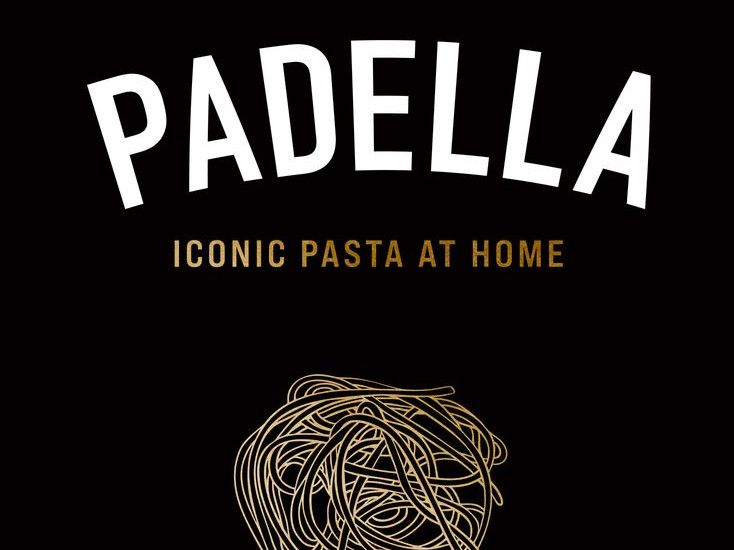“My hope is bringing 20-odd years of theory and being a professional chef, translated into not-chef-talk. I’ve broken it down so it’s easy to follow and some super-simple steps that will elevate your pasta to the next level, whatever level you’re already at.”
So what’s his advice for levelling up your pasta at home?
Give making your own sauce a go
Pasta sauce can be extremely quick and straightforward to whip up at home, says Siadatan – “and it will be far superior to what you’re buying in a jar.
Don’t buy the cheapest dried pasta
Siadatan says ‘bronze-die’ pasta is higher quality. “It gives little ridges on the pasta that helps the sauce cling onto it – it won’t be the cheapest one”, and anything organic is a good sign too.
Cook dried pasta for less time
“The key, when you’re cooking dried pasta, is to always cook it for two or three minutes less than what it says on the packet,” he says.
Learn a solid tomato sauce
“In summer, go with fresh tomatoes and make a quick tomato sauce – it’s fresher, it’s lighter, it chimes with the warm summer weather, it’s what your body is after. The key is to use super-bright tomatoes and you won’t go far wrong,” says Siadatan.
Don’t pour away the starchy water
A step a lot of homecooks miss out is utilising the water the pasta has cooked in for the sauce. “It’s crucial,” says Siadatan. “A lot of the sauces you make with pasta, you need that starchy water to bring that sauce together – it’s one of the major attributes to making pasta exceptional. It’s not the case with everything, but the vast majority.”
Stir and toss the dish
It’s important to make sure the pasta is really well mixed with the sauce – “especially with fresh pasta, with dried as well, but fresh pasta even more so, to work it in the pan.
Stracci with pistachio, mint and basil pesto
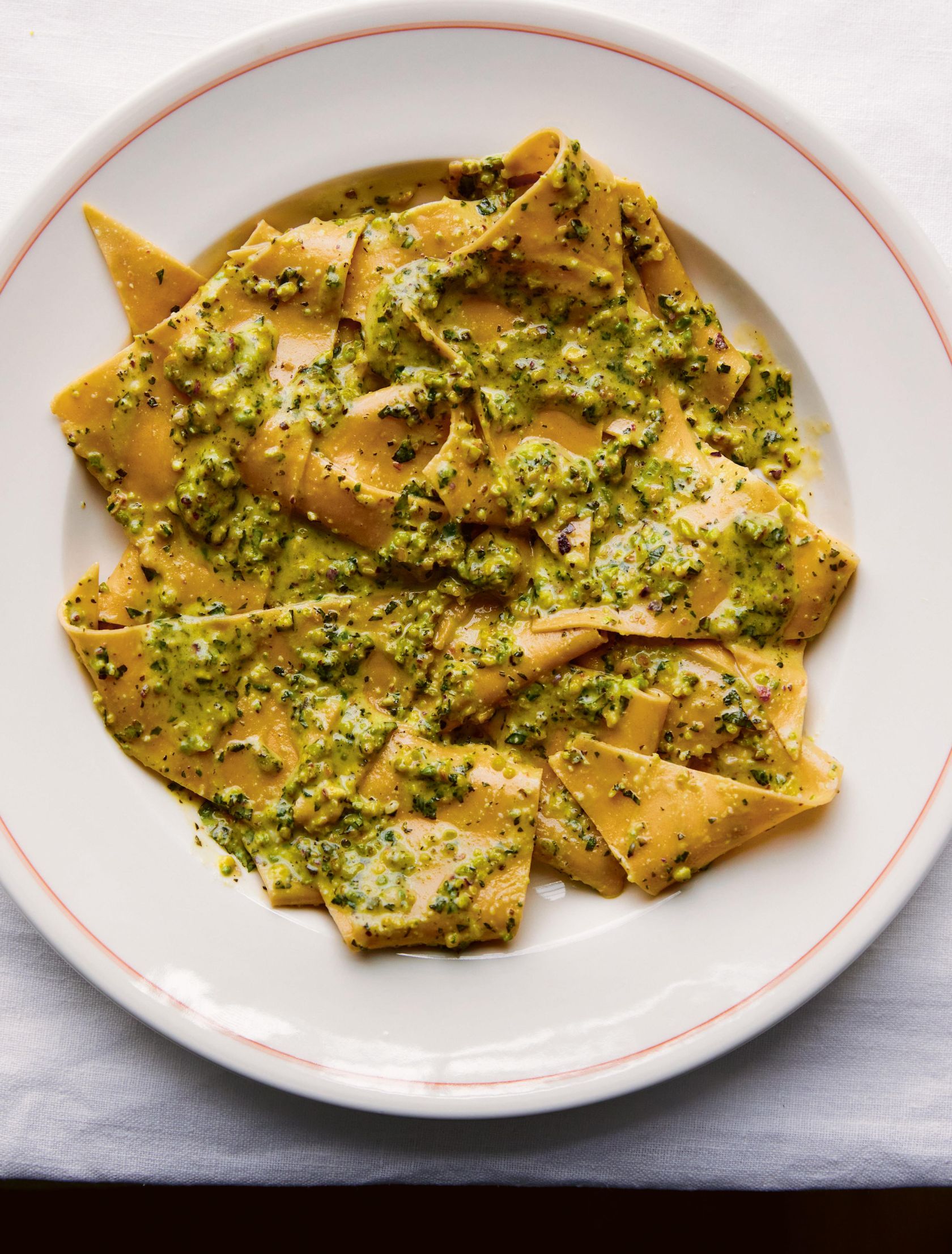
Ingredients:
(Serves 4)
450g fresh stracci (also works with: fresh tagliarini, fettuccine; dried linguine, spaghetti, bucatini, penne, fusilli)
Finely grated zest and juice of ½ lemon
Sea salt
Pistachio, mint and basil pesto
300g shelled dark green pistachio nuts (Sicilian or Persian ones are best)
30g mint leaves, finely chopped
30g basil leaves, finely chopped
200ml extra virgin olive oil
80g Parmesan, finely grated
Method:
1. For the pasta, in a large cooking pot, bring 4–5 litres of water to the boil and add a fistful of salt.
2. Meanwhile, to make the pesto, using a pestle and mortar, pound the pistachio nuts to a crumb texture, then add the chopped herbs, extra virgin olive oil and grated Parmesan and stir to combine. If the mortar isn’t big enough, transfer the pistachio crumbs to a bowl and stir through the other ingredients, seasoning with salt to taste. (Alternatively, pulse the pistachios in a blender to crumbs, then add the remaining ingredients and whiz for a few seconds to combine.)
3. Put roughly 300g of pesto into a pan large enough to hold the cooked pasta as well and add half a mug (about 120ml) of the seasoned pasta water, along with the lemon zest and juice, to loosen it. Drop the stracci into the boiling water and cook for about 1–1½ minutes. Drain the pasta as soon as it’s ready, keeping two mugs of pasta water.
4. Transfer the pasta to the pesto and stir over a medium heat with a spatula or wooden spoon for 30 seconds or so, adding splashes of the reserved pasta water to help the pasta and sauce come together. You are looking to achieve that nice creamy consistency, not too wet and not too dry. Taste and adjust the seasoning if required. Serve the pasta on hot plates and eat immediately.
Tagliarini with crab, chilli, lemon and parsley
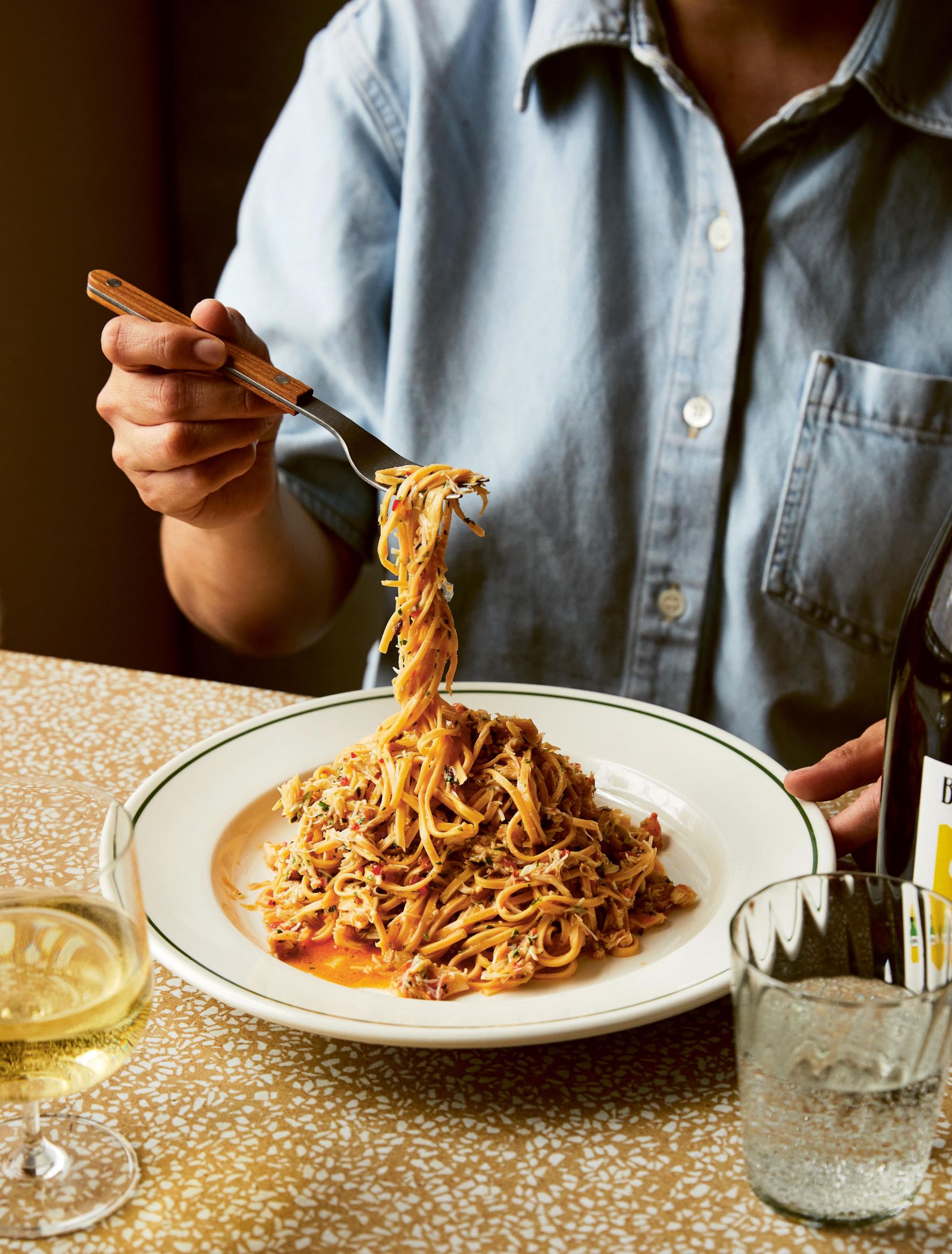
Ingredients:
(Serves 4)
450g fresh tagliarini (also works with: fresh fettuccine; dried linguine, spaghetti or bucatini)
300g freshly picked white crab meat
150g freshly picked brown crab meat
2 heaped tbsp finely chopped red chilli (deseeded)
Finely grated zest and juice of 1 lemon
2 heaped tbsp finely chopped flat-leaf parsley
About 150ml high-quality extra virgin olive oil, plus extra to finish
Sea salt and freshly ground black pepper
Method:
1. For the pasta, in a large cooking pot, bring 4–5 litres of water to the boil and add a fistful of salt.
2. In a large bowl, mix the white and brown crab meat together with the chilli, lemon zest and juice, chopped parsley and about 150ml of the extra virgin olive oil. Season with salt and pepper to taste.
3. Transfer the crab mixture to a pan large enough to easily hold the cooked pasta as well and add a small ladle (about 60ml) of the seasoned pasta water. Stir (off the heat) to combine; the hot pasta water will warm the crab through.
4. Loosen the pasta bundles through your fingers so they won’t stick together as they cook. Drop the tagliarini into the boiling water and cook for about 1–1½ minutes. Drain the pasta as soon as it’s ready, keeping two mugs of pasta water.
5. Add the pasta to the crab mixture with half a mug (about 120ml) of pasta water. Stir vigorously over a medium heat for about 1 minute until all the crab is coated around the pasta and the sauce has thickened. You might need to add splashes of the reserved pasta water to loosen the sauce if it becomes too dry. Be careful to add just enough to get the consistency of the sauce right; if it’s too thin, you’ll end up overcooking the delicate crab as you reduce the sauce. Taste and adjust the seasoning with salt and/or pepper if required.
6. Divide the pasta between hot plates, drizzle with extra virgin olive oil and eat immediately.
Pici cacio e pepe
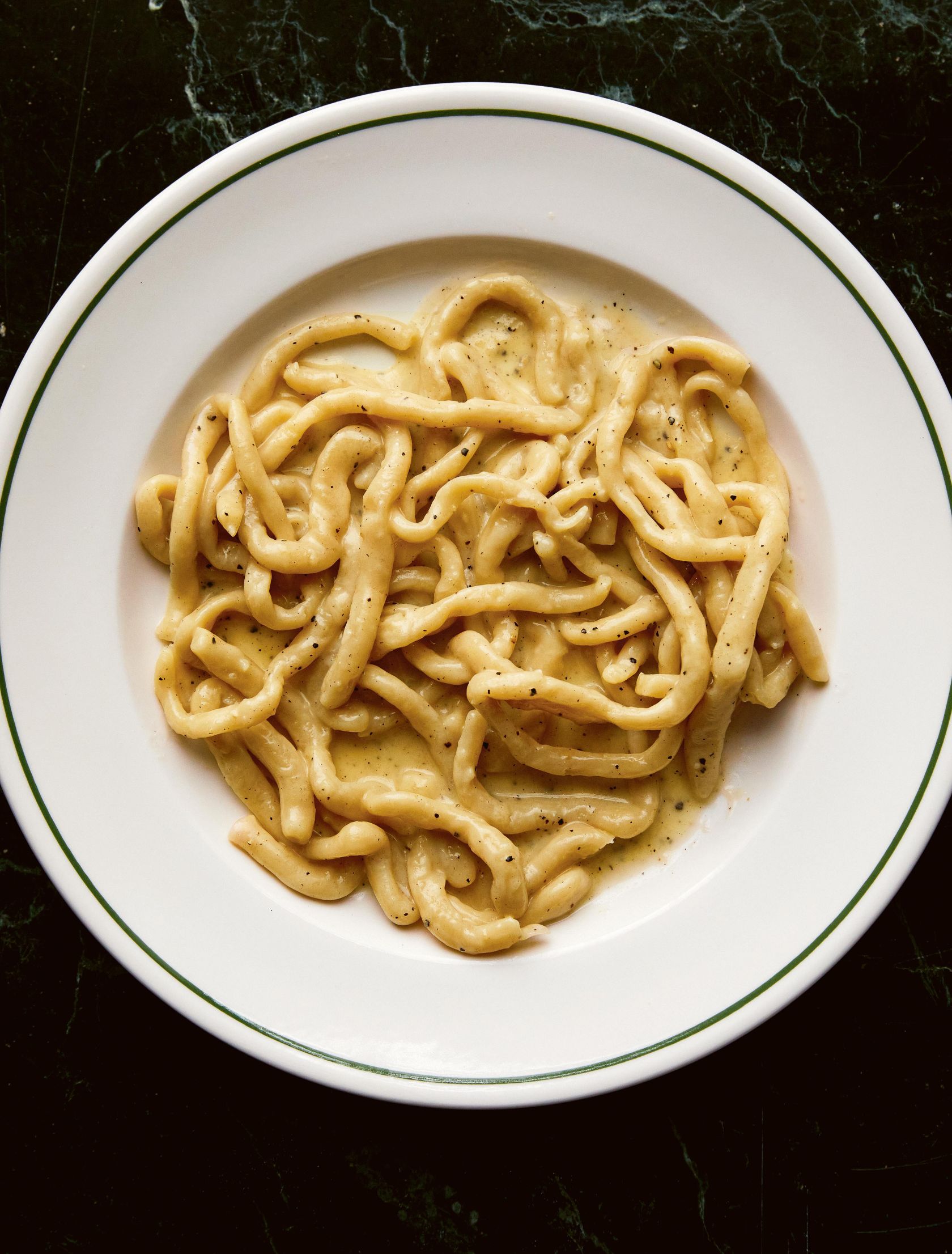
Ingredients:
(Serves 4)
500g fresh pici (also works with fresh tagliarini, fettuccine; dried linguine, spaghetti, bucatini, penne or rigatoni)
About 1 heaped tsp freshly cracked black pepper
110g unsalted butter, cubed
A squeeze of lemon juice (about 10ml)
110g Parmesan, finely grated
Sea salt
Method:
1. For the pici, in a large cooking pot, bring 4–5 litres of water to the boil and add a fistful of salt.
2. At the same time, in a pan large enough to easily hold all of the cooked ingredients, toast the freshly cracked pepper over a high heat for roughly 45–60 seconds or until you can smell the pepper, shaking the pan regularly to prevent it burning. Immediately add around 200ml of the seasoned pasta water (it will sizzle) and take the pan off the heat for 30 seconds.
3. Put the pan back over a medium-low heat, add the butter with the lemon juice to melt gently, then take off the heat. (It’s important to keep it off the heat while you cook the pasta, so that the pan isn’t scorching hot when you add the Parmesan.)
4. Loosen the pici bundles through your fingers so they won’t stick together as they cook. Drop the pici into the boiling water and cook for around 5 minutes.
5. Drain the pici as soon as it’s ready, keeping two mugs of pasta water.
6. Transfer the cooked pici to the buttery pepper sauce, put the pan back over a medium heat and stir until fully coated. Don’t worry if it looks quite soupy at this stage; the sauce will thicken more quickly than you think.
7. Add the grated Parmesan to the pici and stir vigorously to melt it into the sauce. You should see a bit of steam rising out of the pan as you stir, so adjust your heat up if this isn’t happening. You might need to add small splashes of the reserved pasta water if the sauce needs loosening, stirring until you achieve a smooth, oozy sauce. Once you’re happy with the consistency of the sauce, serve up the pasta on hot plates. Eat straight away.
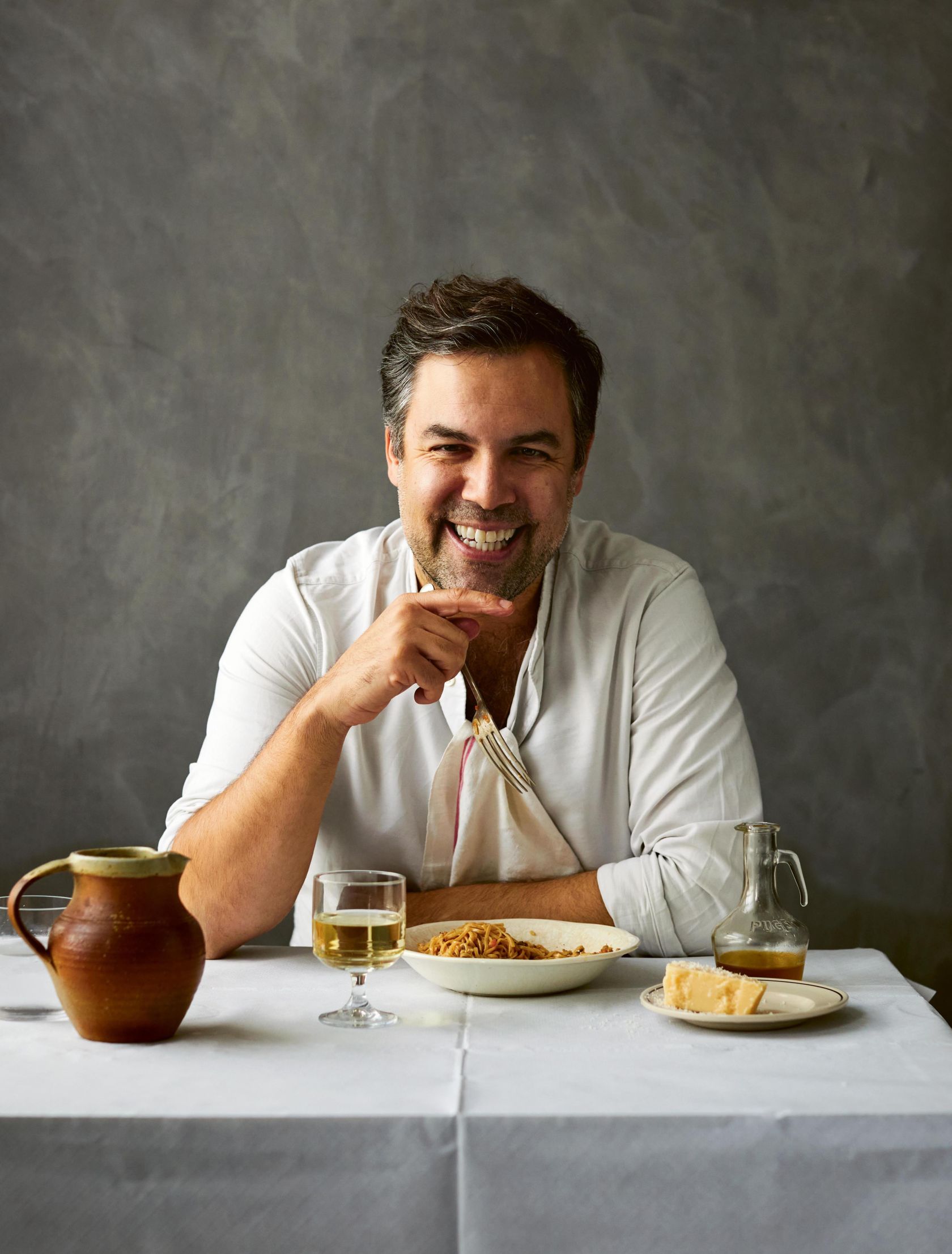
Padella by Tim Siadatan is published in hardback by Bloomsbury Publishing

